Related Research Articles

The Phoenician alphabet is an alphabet known in modern times from the Canaanite and Aramaic inscriptions found across the Mediterranean region.

Pre-Columbian transoceanic contact theories are speculative theories which propose that possible visits to the Americas, possible interactions with the indigenous peoples of the Americas, or both, were made by people from Africa, Asia, Europe, or Oceania prior to Christopher Columbus' first voyage to the Caribbean in 1492. There is a growing body of evidence indicating that the earliest human migrations to the Americas may have been made by sea voyages, contemporary with and possibly predating land migrations over the Beringia land bridge, which during the glacial period joined what today are Siberia and Alaska. Whether transoceanic travel continued into the historic period, resulting in pre-Columbian contact between the settled American peoples and voyagers from other continents, is vigorously debated.
Ugaritic is an extinct Northwest Semitic language, classified by some as a dialect of the Amorite language and so the only known Amorite dialect preserved in writing. It is known through the Ugaritic texts discovered by French archaeologists in 1929 at Ugarit, including several major literary texts, notably the Baal cycle. It has been used by scholars of the Hebrew Bible to clarify Biblical Hebrew texts and has revealed ways in which the cultures of ancient Israel and Judah found parallels in the neighboring cultures.

"Ancient astronauts" refers to a pseudoscientific hypothesis which holds that intelligent extraterrestrial beings visited Earth and made contact with humans in antiquity and prehistoric times. Proponents suggest that this contact influenced the development of modern cultures, technologies, religions, and human biology. A common position is that deities from most, if not all, religions are extraterrestrial in origin, and that advanced technologies brought to Earth by ancient astronauts were interpreted as evidence of divine status by early humans.
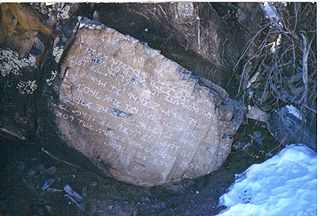
The Los Lunas Decalogue Stone is a large boulder on the side of Hidden Mountain, near Los Lunas, New Mexico, about 35 miles (56 km) south of Albuquerque, that bears a very spectacular inscription carved into a flat panel. The stone is also known as the Los Lunas Mystery Stone or Commandment Rock. The stone is controversial in that some claim the inscription is Pre-Columbian, and therefore proof of early Semitic contact with the Americas.
The Punic language, also called Phoenicio-Punic, is an extinct variety of the Phoenician language, a Canaanite language of the Northwest Semitic branch of the Semitic languages. An offshoot of its parent Phoenician language of coastal West Asia, it was principally spoken on the Mediterranean coast of Northwest Africa, and also in the Iberian peninsula and several Mediterranean islands such as Malta and Sicily by the Punic people/Phoenicians throughout Classical antiquity, from the 8th century BCE to the 6th century CE.
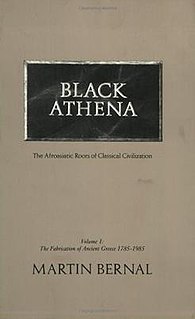
Black Athena: The Afroasiatic Roots of Classical Civilization, its three volumes first published in 1987, 1991, and 2006 respectively, is a controversial and pseudo-historic book by Martin Bernal proposing an alternative hypothesis on the origins of ancient Greece and classical civilisation. Bernal's thesis discusses the perception of ancient Greece in relation to Greece's African and Asiatic neighbors, especially the ancient Egyptians and Phoenicians who, he believes, colonized ancient Greece. Bernal proposes that a change in the Western perception of Greece took place from the 18th century onward and that this change fostered a subsequent denial by Western academia of any significant African and Phoenician influence on ancient Greek civilization.

Eblaite, or Palaeo-Syrian, is an extinct East Semitic language used during the 3rd millennium BCE by the populations of Northern Syria. It was named after the ancient city of Ebla, in modern western Syria. Variants of the language were also spoken in Mari and Nagar. According to Cyrus H. Gordon, although scribes might have spoken it sometimes, Eblaite was probably not spoken much, being rather a written lingua franca with East and West Semitic features.
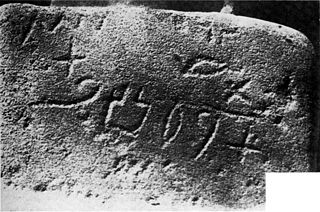
Proto-Sinaitic is considered the earliest trace of alphabetic writing and the common ancestor of both the Ancient South Arabian script and the Phoenician alphabet, which led to many modern alphabets including the Greek alphabet. According to common theory, Canaanites or Hyksos who spoke a Semitic language repurposed Egyptian hieroglyphs to construct a different script. The script is attested in a small corpus of inscriptions found at Serabit el-Khadim in the Sinai Peninsula, Egypt, dating to the Middle Bronze Age.
The history of the alphabet goes back to the consonantal writing system used for Semitic languages in the Levant in the 2nd millennium BCE. Most or nearly all alphabetic scripts used throughout the world today ultimately go back to this Semitic proto-alphabet. Its first origins can be traced back to a Proto-Sinaitic script developed in Ancient Egypt to represent the language of Semitic-speaking workers and slaves in Egypt. Unskilled in the complex hieroglyphic system used to write the Egyptian language, which required a large number of pictograms, they selected a small number of those commonly seen in their Egyptian surroundings to describe the sounds, as opposed to the semantic values, of their own Canaanite language. This script was partly influenced by the older Egyptian hieratic, a cursive script related to Egyptian hieroglyphs.
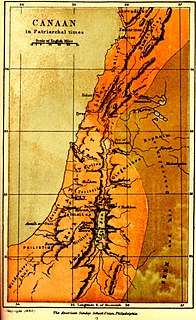
The Canaanite religion was the group of ancient Semitic religions practiced by the Canaanites living in the ancient Levant from at least the early Bronze Age through the first centuries AD. Canaanite religion was polytheistic and, in some cases, monolatristic.
Cyrus Herzl Gordon was an American scholar of Near Eastern cultures and ancient languages.
The Atlantic languages of Semitic or "Semitidic" (para-Semitic) origin are a disputed concept in historical linguistics put forward by Theo Vennemann. He proposed that Semitic-language-speakers occupied regions in Europe thousands of years ago and influenced the later European languages that are not part of the Semitic family. The theory has found no notable acceptance among linguists or other relevant scholars and is criticised as being based on sparse and often-misinterpreted data.
Alan F. Alford, was a British writer and speaker on the subjects of ancient religion, mythology, and Egyptology.

Ancient astronauts have been addressed frequently in science fiction and horror fiction. Occurrences in the genres include:
Hugh Bernard Fox Jr. was a writer, novelist, poet and anthropologist and one of the founders of the Pushcart Prize for literature. He has been published in numerous literary magazines and was the first writer to publish a critical study of Charles Bukowski.
Tertius Chandler (1915–2000) from Berkeley, California was a historian and author.

Phoenicia was an ancient thalassocratic civilization originating in the Levant region of the eastern Mediterranean, primarily located in modern Lebanon. It was concentrated along the coast of Lebanon and included some coastal areas of modern Syria and Palestine, reaching as far north as Arwad, and as far south as Acre and possibly Gaza. At its height between 1100 and 200 BC, the Phoenician civilization spanned the Mediterranean from Cyprus to the Iberian Peninsula.
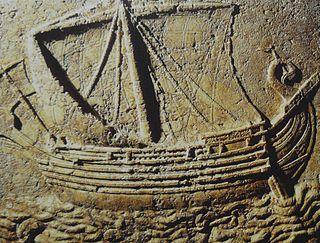
The theory of Phoenician discovery of the Americas suggests that the earliest Old World contact with the Americas was not with Columbus or Norse settlers, but with the Phoenicians in the first millennium BC.

The Epsilon Team is an alleged secret society that appears in Greek modern folklore, conspiracy theories and ufology. The team was first described in a 1977 book, and supposedly consists of prominent Greek people who possess secret knowledge of extraterrestrial origin. Beginning in the 1980s, literature about the society became infused with anti-Semitic conspiracy theories, placing the Epsilon Team in a cosmic battle against the Jews. The body of beliefs related to the Epsilon Team has been labeled epsilonism, and those who subscribe to it have been labeled epsilonists.
References
- ↑ Randall Fitzgerald, Cosmic test tube: extraterrestrial contact, theories and evidence, Moon Lake Media, 1998, p. 55
- ↑ Natalie Robins, Steven M. L. Aronson, Savage Grace: The True Story of Fatal Relations in a Rich and Famous American Family, 2007, p. 488
- ↑ Éire-Ireland: a journal of Irish studies, Volume 5; Volume 5, Irish American Cultural Institute., 1966, p. 145
- ↑ The Critic, Volume 27, Issue 6, Thomas More Association, 1969
- 1 2 3 Phil C. Weigand (September 1978). "Review: Reviewed Works: In Search of Noah's Ark by Dave Balsiger, Charles E. Sellier, Jr.; Remote Kingdoms by Tertius Chandler; The Key by John Philip Cohane; Gods of the Cataclysm: A Revolutionary Investigation of Man and his Gods before and after the Great Cataclysm by Hugh Fox". American Anthropologist. New Series. 80 (3): 731–733. doi: 10.1525/aa.1978.80.3.02a00760 . JSTOR 677086.
- ↑ Osbert Guy Stanhope Crawford, Antiquity: a quarterly review of archaeology, Volumes 51-53, Antiquity Publications, 1977
- ↑ The Reprint bulletin, Volumes 23-24, American Library Association, Oceana Publications, 1978, p. 14
- ↑ Cyrus Herzl Gordon, Before Columbus; links between the Old World and ancient America, Crown, 1971, p. 138
- ↑ Eugene R. Fingerhut, Explorers of pre-Columbian America?: the diffusionist-inventionist controversy, Regina Books, 1994, p. 222
- ↑ "The origins of the Hebrew Alphabet". www.ancient-hebrew.org. Archived from the original on 2007-10-21.
- ↑ The New York Times book review, The New York Times Company, 1977 p. 40
- ↑ Gelb I. J (1973). "Reviewed Work: The Key by John Philip Cohane". Journal of the American Oriental Society. 93 (3): 396–397. doi:10.2307/599561. JSTOR 599561.